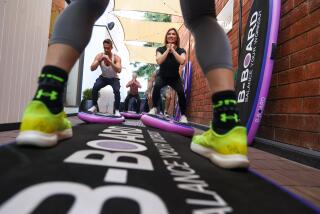Stroke, sweat and glide
- Share via
Paddle blades flash through the water, pumping in and out in a hypnotic, synchronized motion, sending a gleaming outrigger skimming across the ocean’s surface. The canoe quickly reaches paddling nirvana: “the glide.”
Five paddlers work in a trance, eyes locked on the back and paddle of the person in front of them, torsos twisting and dipping with machine-like precision and timing.
Sweat starts to bead on their heads as the boat slides over swells.
Paddles plunge into the water in perfect harmony, sending swirls of bubbles racing back alongside the reflection of the salt-stained white outrigger, which dances with the ripples and contours of the surface.
The workout becomes group meditation, five people melding minds and bodies to make a canoe fly.
Outriggers, the long, narrow canoes that morphed from dug-out koa logs to modern fiberglass works of engineering, fill an outdoor niche and has dual appeal: tough workouts on the water and a laid-back attitude off the water.
Paddlers form a tight-knit community characterized by an easy atmosphere in which moms, dads and kids join the same club.
“It’s a lifestyle,” says Greg Ofner, 34, assistant coach at Ka Nai’a Outrigger Canoe Club in Santa Barbara, where his parents are head coaches. “This is what I grew up with.”
The family atmosphere also draws a growing number of young women, many of whom relish the opportunity to finesse their way past men in athletic competition.
“You can see a woman who might be very small in stature but has very good technique, and she could outpaddle and go faster than a guy who might be larger than she is,” says Wendy DeWitt, head coach at Kai Elua Outrigger Canoe Club in San Diego. “I think that’s pretty appealing to women.”
The same holds true in other paddle sports like kayaking, but traditional outrigging adds the communal element.
“It’s an opportunity for women to really bond and form friendships,” says Carol Schick, president of the Southern California Outrigger Racing Assn.
Although equipment has evolved since ancient Polynesians island-hopped around the vast Pacific in outriggers, the basic concept of hard-charging teamwork hasn’t changed. Without practiced timing and technique, the boat struggles against itself, a hesitant wobble that experienced paddlers can feel on the water.
“You can’t paddle ... on your own,” says Ofner. “Finesse is a huge part of achieving the glide. If you’re out there freelancing, you’re not going to get that.”
Hawaiian Albert Edward “Toots” Minvielle introduced outriggers to California in 1959 -- the year Hawaii became a state -- by toting two traditional wooden canoes over from the islands.
The first race, with Hawaiian surfing and swimming legend Duke Kahanamoku serving as grand marshal, went from Catalina Island to the Newport Dunes.
Although it’s not always emphasized in California clubs, the sport still draws heavily on its Polynesian heritage. Most clubs take a Hawaiian name -- Ka Nai’a means dolphin -- and paddlers salute each other with “aloha” and “mahalo.” They also call the outrigger an “ama” and shout out paddle changes in Hawaiian.
Clubs scattered up and down the coast train hard for the racing season, but they also welcome novice paddlers at open house paddles and practices.
At one such event, Ofner and his fellow paddlers push a 40-foot, 400-pound fiberglass canoe into the water of Santa Barbara harbor.
When the boat floats the paddlers wade in, then jump in at their assigned seat positions.
The canoe has six bench seats, and each seat carries with it a certain responsibility. The first seat sets the stroke rate. No. 2 paddles on the opposite side and must copy No. 1. Three, four and five provide the power, synchronizing their paddling with that of the person two seats in front of them; on long races they also bail the water out of the boat. The fifth person also steers.
Each team member paddles on one side for a while; then a person calls out a change, barking out staccato Hawaiian words that make him sound a bit like a football quarterback calling out signals.
On this day, Ofner plays quarterback. The words ring out across the harbor, in time with the paddle strokes. On the third stroke, all the paddlers pull out and switch sides in a fluid movement.
The harbor is quiet except for Ofner and the sound of five paddles splashing in, drawing water and dripping on exit.
A cormorant takes wing as the boat glides past, leaving little ripples and rings behind; the boat turns around a floating dock where a group of pelicans stand to catch the rising sun.
The steersman guides the boat out of the harbor in a straight line and then swings a tight loop around a rusted red buoy. Gentle swells roll through, causing the boat to rise and fall with a sigh. Minnows pop at the surface in a flash of silver.
In the boat, no one speaks. The paddles stay locked in rhythm, Ofner calls out the changes and the coastline flies by for half an hour.
On the way back, a man fishing on the breakwater calls out: “Hey, is that as fast as you can go? Stroke! Stroke!” On his second cry the steersman calls for the boat to relax, and the paddlers slow down to reenter the harbor. The canoe glides past a tired old fishing boat.
As their energy subsides, arms loose and relaxed, the paddlers edge the boat back into the shallows and hop out. They drag the outrigger out of the water and up the beach. Together, they wipe it down and walk away.


